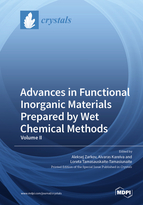Advances in Functional Inorganic Materials Prepared by Wet Chemical Methods (Volume II)
A special issue of Crystals (ISSN 2073-4352). This special issue belongs to the section "Inorganic Crystalline Materials".
Deadline for manuscript submissions: closed (31 December 2022) | Viewed by 29253
Special Issue Editors
Interests: functional inorganic materials; mixed metal oxides; inorganic biomaterials; nanomaterials; thin films; ceramics
Special Issues, Collections and Topics in MDPI journals
Interests: multifunctional metal oxides; catalysts; microstructure; physical properties; nanoparticles; nanoclusters; nanocomposites; solid-state chemistry
Special Issues, Collections and Topics in MDPI journals
Interests: nanoparticles; composites; metals; multifunctional materials; catalysts; fuel cells
Special Issues, Collections and Topics in MDPI journals
Special Issue Information
Dear Colleagues,
Functional inorganic materials are an indispensable part of innovative technologies, which are essential to the development of many fields of industry. The use of new materials, nanostructures, or multicomponent composites with specific chemical or physical properties promotes technological progress in electronics, optoelectronics, catalysis, biomedicine, and many other areas that are concerned with plenty of aspects of human life. Due to the broad and diverse range of potential applications of functional inorganic materials, the development of superior synthesis pathways, reliable characterization, and a deep understanding of the structure–property relationships in materials are rightfully considered to be fundamentally important scientific issues. Only synergetic efforts of scientists dealing with the synthesis, functionalization, and characterization of materials will lead to the development of future technologies.
The scope of this Special Issue of Crystals, entitled “Advances in Functional Inorganic Materials Prepared by Wet Chemical Methods (Volumn II)”, includes but is not limited to the preparation routes, characterization, and application of functional inorganic materials, as well as hybrid materials that are important in the fields of electronics, optics, and biomedicine, among others. We would like to invite you to submit your work in the form of an original research article or a review paper related to the investigation of bulk materials, nanomaterials, or thin films.
Dr. Aleksej Zarkov
Dr. Aivaras Kareiva
Dr. Loreta Tamasauskaite-Tamasiunaite
Guest Editors
Manuscript Submission Information
Manuscripts should be submitted online at www.mdpi.com by registering and logging in to this website. Once you are registered, click here to go to the submission form. Manuscripts can be submitted until the deadline. All submissions that pass pre-check are peer-reviewed. Accepted papers will be published continuously in the journal (as soon as accepted) and will be listed together on the special issue website. Research articles, review articles as well as short communications are invited. For planned papers, a title and short abstract (about 100 words) can be sent to the Editorial Office for announcement on this website.
Submitted manuscripts should not have been published previously, nor be under consideration for publication elsewhere (except conference proceedings papers). All manuscripts are thoroughly refereed through a single-blind peer-review process. A guide for authors and other relevant information for submission of manuscripts is available on the Instructions for Authors page. Crystals is an international peer-reviewed open access monthly journal published by MDPI.
Please visit the Instructions for Authors page before submitting a manuscript. The Article Processing Charge (APC) for publication in this open access journal is 2600 CHF (Swiss Francs). Submitted papers should be well formatted and use good English. Authors may use MDPI's English editing service prior to publication or during author revisions.
Keywords
- multifunctional materials
- magnetic materials
- ferroelectric materials
- piezoelectric materials
- optical materials
- processing routes
- ceramics








